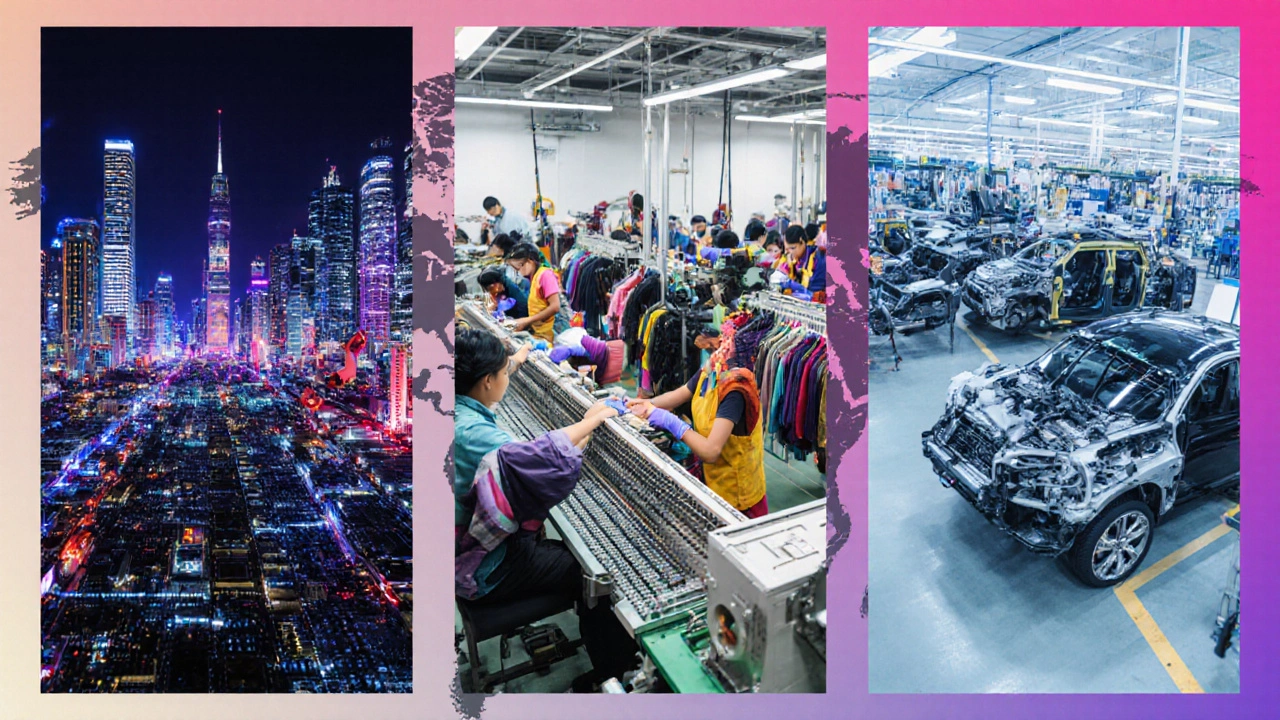U.S. Manufacturing Outsourcing Calculator
Top Offshore Destinations:
U.S. manufacturing is the collection of production activities across more than 1million facilities that generate roughly $2.3trillion in annual output. Over the past two decades a growing share of that output has been U.S. manufacturing outsourcing, meaning components or entire products are built outside the United States and later imported for final assembly or sale.
Key Takeaways
- About 18‑22% of total U.S. manufacturing value‑added was produced overseas in 2024.
- Electronics and apparel lead the outsourcing chart, while food processing and chemicals remain largely domestic.
- China, Mexico, and Vietnam together account for roughly two‑thirds of the outsourced share.
- Reshoring initiatives have trimmed the outsourced share in some sectors but the overall trend stays upward.
- Reliable data comes from the U.S. Census Bureau and the Bureau of Economic Analysis using NAICS‑based supply‑chain tables.
What Exactly Is Outsourced Manufacturing?
In plain terms, outsourcing means a U.S. firm contracts a foreign supplier to produce a part, sub‑assembly, or even a finished good. The contract can be a simple purchase‑order relationship or a long‑term strategic partnership. The term offshoring is often used interchangeably, though offshoring sometimes emphasizes the geographic move of an entire production line.
How Analysts Measure the Outsourced Share
There is no single “outsourcing index.” Researchers combine three core data sources:
- Supply‑chain tables from the U.S. Census Bureau that track where each industry purchases intermediate goods.
- Value‑added data from the Bureau of Economic Analysis (BEA), which shows the domestic contribution of each sector.
- Customs import statistics that record the country‑of‑origin for finished goods and components.
Analysts convert these numbers into a percentage of total manufacturing value‑added that originates outside U.S. borders. The metric is often called the "outsourced manufacturing share."

Overall Outsourced Share in 2024
Using the latest 2022‑2024 data set, the consensus among the Reshoring Initiative and the Institute for Supply Management is that 18‑22% of U.S. manufacturing value‑added was produced abroad. The range reflects methodological differences: the lower bound uses only customs data (more conservative), while the upper bound adds supply‑chain estimates for components that never cross a border but are built by foreign‑owned plants in the U.S.
Sector‑by‑Sector Breakdown
Below is a snapshot of the most commonly cited sectors. Numbers are rounded to the nearest whole percent.
| Sector (NAICS) | Domestic Share | Outsourced Share | Top Offshore Destinations |
|---|---|---|---|
| Electronics (334) | 55% | 45% | China, Vietnam, Mexico |
| Apparel & Textiles (315‑339) | 40% | 60% | Bangladesh, Vietnam, China |
| Automotive (336) | 78% | 22% | Mexico, Canada, China |
| Food Processing (311‑315) | 92% | 8% | Mexico, Canada |
| Pharmaceuticals (325) | 88% | 12% | India, Ireland |
| Machinery (333) | 80% | 20% | Mexico, China |
Why Companies Choose to Outsource
Three forces dominate the decision‑making process:
- Cost advantage: Labor rates in China ($5‑$7 per hour) and Vietnam ($2‑$3) are still far below the U.S. average ($28). Even after shipping and tariff costs, the margin can be 15‑25% higher.
- Specialized capacity: Certain high‑volume micro‑electronics fabs or large‑scale textile looms exist only in a handful of overseas parks.
- Speed to market: Established supply‑chain ecosystems in Southeast Asia can shrink product development cycles by months.
These drivers are amplified by trade agreements like the U.S.-Mexico-Canada Agreement (USMCA), which lowered tariff barriers for many intermediate goods, making cross‑border sourcing even more attractive.

Reshoring: Is the Tide Turning?
Since 2020, geopolitical tensions and pandemic‑related supply shocks have sparked a “reshoring” push. The Reshoring Initiative reports that between 2020 and 2024, about 1.2% of previously outsourced value‑added returned to domestic plants. Automotive and medical device firms led the movement, driven by incentives such as the Inflation Reduction Act’s tax credits for U.S.-based production.
Nevertheless, reshoring has not erased outsourcing. The net effect is a modest dip in the overall outsourced share-from roughly 22% in 2020 to the current 18‑22% range. The biggest “wins” are in high‑margin categories where automation can offset higher labor costs.
How to Interpret the Numbers for Your Business
If you’re a supply‑chain manager, the key takeaway is that the outsourced share is sector‑specific, not a blanket figure. Some questions to ask yourself:
- Which components of my product are already sourced abroad? Look at your Bill of Materials and map each line item to its country of origin.
- What would be the cost differential if I moved that component back? Include tariffs, freight, and any on‑shore labor surcharge.
- Are there strategic risks (e.g., geopolitical, ESG) that outweigh pure cost savings?
Running a quick “outsourcing audit” using the data sources above will give you a realistic picture of exposure and help you decide whether reshoring or diversifying suppliers is the right move.
Future Outlook (2025‑2030)
Analysts project a slow but steady decline in the overall outsourced share, landing around 16‑18% by 2030. The drivers include:
- Automation that reduces the labor cost gap.
- Continued incentives for domestic high‑tech manufacturing.
- Supply‑chain resilience strategies that favor regional hubs over distant factories.
However, emerging economies in Africa and South‑East Asia will still offer competitive advantages for low‑value, labor‑intensive goods, keeping the outsourced share above 15% for the foreseeable future.
Frequently Asked Questions
What percentage of U.S. manufacturing is currently outsourced?
Most recent estimates place the outsourced share between 18% and 22% of total manufacturing value‑added, with variations across sectors.
Which countries receive the most U.S. outsourced production?
China remains the largest destination, followed by Mexico and Vietnam. Together they account for roughly two‑thirds of the outsourced output.
How reliable are the data sources for outsourcing statistics?
The most credible sources are the U.S. Census Bureau’s supply‑chain tables, the BEA’s value‑added accounts, and customs import records. Combining them provides a triangulated view that mitigates the weaknesses of any single source.
Has reshoring reduced the outsourced share significantly?
Reshoring has reclaimed about 1‑2% of the outsourced share since 2020, mainly in automotive, medical devices, and high‑tech equipment. The overall trend remains upward because of cost pressures in other sectors.
What should a small manufacturer do if they’re considering outsourcing?
Start with a detailed cost‑benefit analysis of each component, factor in tariffs and lead‑time, and evaluate supplier reliability. Use the Census/Bureau data to benchmark industry norms before committing.






